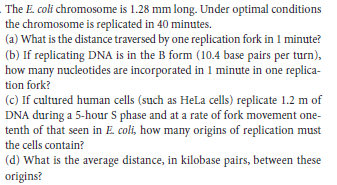The E. coli chromosome is 1.28 mm long. Under optimal conditions the chromosome is replicated in 40 minutes. (a) What is the distance traversed by one replication fork in 1 minute? (b) If replicating DNA is in the B form (10.4 base pairs per turn), how many nucleotides are incorporated in 1 minute in one replica- tion fork? (c) If cultured human cells (such as Hela cells) replicate 1.2 m of DNA during a 5-hour S phase and at a rate of fork movement one- tenth of that seen in E. coli, how many origins of replication must the cells contain? (d) What is the average distance, in kilobase pairs, between these origins?
The E. coli chromosome is 1.28 mm long. Under optimal conditions the chromosome is replicated in 40 minutes. (a) What is the distance traversed by one replication fork in 1 minute? (b) If replicating DNA is in the B form (10.4 base pairs per turn), how many nucleotides are incorporated in 1 minute in one replica- tion fork? (c) If cultured human cells (such as Hela cells) replicate 1.2 m of DNA during a 5-hour S phase and at a rate of fork movement one- tenth of that seen in E. coli, how many origins of replication must the cells contain? (d) What is the average distance, in kilobase pairs, between these origins?
Biochemistry
9th Edition
ISBN:9781319114671
Author:Lubert Stryer, Jeremy M. Berg, John L. Tymoczko, Gregory J. Gatto Jr.
Publisher:Lubert Stryer, Jeremy M. Berg, John L. Tymoczko, Gregory J. Gatto Jr.
Chapter1: Biochemistry: An Evolving Science
Section: Chapter Questions
Problem 1P
Related questions
Question

Transcribed Image Text:The E. coli chromosome is 1.28 mm long. Under optimal conditions
the chromosome is replicated in 40 minutes.
(a) What is the distance traversed by one replication fork in 1 minute?
(b) If replicating DNA is in the B form (10.4 base pairs per turn),
how many nucleotides are incorporated in 1 minute in one replica-
tion fork?
(c) If cultured human cells (such as Hela cells) replicate 1.2 m of
DNA during a 5-hour S phase and at a rate of fork movement one-
tenth of that seen in E. coli, how many origins of replication must
the cells contain?
(d) What is the average distance, in kilobase pairs, between these
origins?
Expert Solution
This question has been solved!
Explore an expertly crafted, step-by-step solution for a thorough understanding of key concepts.
This is a popular solution!
Trending now
This is a popular solution!
Step by step
Solved in 2 steps

Recommended textbooks for you

Biochemistry
Biochemistry
ISBN:
9781319114671
Author:
Lubert Stryer, Jeremy M. Berg, John L. Tymoczko, Gregory J. Gatto Jr.
Publisher:
W. H. Freeman

Lehninger Principles of Biochemistry
Biochemistry
ISBN:
9781464126116
Author:
David L. Nelson, Michael M. Cox
Publisher:
W. H. Freeman

Fundamentals of Biochemistry: Life at the Molecul…
Biochemistry
ISBN:
9781118918401
Author:
Donald Voet, Judith G. Voet, Charlotte W. Pratt
Publisher:
WILEY

Biochemistry
Biochemistry
ISBN:
9781319114671
Author:
Lubert Stryer, Jeremy M. Berg, John L. Tymoczko, Gregory J. Gatto Jr.
Publisher:
W. H. Freeman

Lehninger Principles of Biochemistry
Biochemistry
ISBN:
9781464126116
Author:
David L. Nelson, Michael M. Cox
Publisher:
W. H. Freeman

Fundamentals of Biochemistry: Life at the Molecul…
Biochemistry
ISBN:
9781118918401
Author:
Donald Voet, Judith G. Voet, Charlotte W. Pratt
Publisher:
WILEY

Biochemistry
Biochemistry
ISBN:
9781305961135
Author:
Mary K. Campbell, Shawn O. Farrell, Owen M. McDougal
Publisher:
Cengage Learning

Biochemistry
Biochemistry
ISBN:
9781305577206
Author:
Reginald H. Garrett, Charles M. Grisham
Publisher:
Cengage Learning

Fundamentals of General, Organic, and Biological …
Biochemistry
ISBN:
9780134015187
Author:
John E. McMurry, David S. Ballantine, Carl A. Hoeger, Virginia E. Peterson
Publisher:
PEARSON